|
GODS OF HEAVEN
AND EARTH
WHAT WAS IT that after hundreds of thousands and even millions of
years of painfully slow human development abruptly changed
everything so completely, and in a one - two-three punch - circa
11,000-7400-3800 B.C. - transformed primitive nomadic hunters and
food gatherers into farmers and pottery makers, and then into
builders of cities, engineers, mathematicians, astronomers,
metallurgists, merchants, musicians, judges, doctors, authors,
librarians, priests?
One can go further and ask an even more basic
question, so well stated by Professor Robert J. Braid-wood
(Prehistoric Men):
"Why did it happen at all? Why are all human
beings not still living as the Maglemosians did?"
The Sumerians, the people through whom this high civilization so
suddenly came into being, had a ready answer. It was summed up by
one of the tens of thousands of ancient Mesopotamian inscriptions
that have been uncovered: "Whatever seems beautiful, we made by the
grace of the gods."
The gods of Sumer. Who were they?
Were the gods of the Sumerians like the Greek gods, who were
described as living at a great court, feasting in the Great Hall of
Zeus in the heavens - Olympus, whose counterpart on earth was
Greece's highest peak, Mount Olympus?
The Greeks described their gods as anthropomorphic, as physically
similar to mortal men and women, and human in character: They could
be happy and angry and jealous; they made love, quarreled, fought;
and they procreated like humans, bringing forth offspring through
sexual intercourse - with each other or with humans.
They were unreachable, and yet they were constantly mixed up in
human affairs. They could travel at immense speeds, appear and
disappear; they had weapons of immense and unusual power. Each had
specific functions, and, as a result, a specific human activity
could suffer or benefit by the attitude of the god in charge of that
particular activity; therefore, rituals of worship, and offerings
to the gods were supposed to gain their favor.
The principal deity of the Greeks during their Hellenic civilization
was Zeus, "Father of Gods and Men," "Master of the Celestial Fire."
His chief weapon and symbol was the thunderbolt. He was a "king"
upon earth who had descended from the heavens; a decision maker and
the dispenser of good and evil to mortals, yet one whose original
domain was in the skies.
He was neither the first god upon Earth nor the first deity to have
been in the heavens. Mixing theology with cosmology to come up with
what scholars treat as mythology, the Greeks believed that first
there was Chaos; then Gaea (Earth) and her consort Uranus (the
heavens) appeared. Gaea and Uranus brought forth the twelve Titans,
six males and six females. Though their legendary deeds look place
on Earth, it is assumed that they had astral counterparts.
Cronus, the youngest male Titan, emerged as the principal figure in
Olympian mythology. He rose to supremacy among the Titans through
usurpation, after castrating his father Uranus. Fearful of the other
Titans, Cronus imprisoned and banished them. For that, he was cursed
by his mother: He would suffer the same fate as his father, and be
dethroned by one of his own sons.
Cronus consorted with his own sister Rhea, who bore him three sons
and three daughters; Hades, Poseidon, and Zeus; Hestia, Demeter, and
Hera. Once again, it was fated that the youngest son would be the
one to depose his hither, and the curse of Gaea came true when Zeus
over-threw Cronus, his father.
The overthrow, it would seem, did not go smoothly. For many years
battles between the gods and a host of
monstrous beings ensued. The decisive battle was between Zeus and
Typhon, a serpent-like deity. The fighting ranged over wide areas,
on Earth and in the skies.
The final battle took place at Mount Casius, near the boundary between Egypt and Arabia - apparently
somewhere in the Sinai Peninsula.
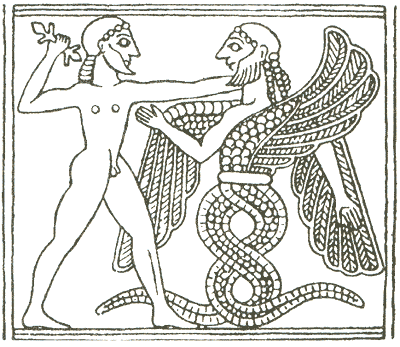
Having won the struggle, Zeus was recognized as the supreme deity.
Nevertheless, he had to share control with his brothers. By choice
(or, according to one version, through the throwing of lots), Zeus
was given control of the skies, the eldest brother Hades was
accorded the Lower World, and the middle brother Poseidon was given
mastery of the seas.
Though in time Hades and his region became a synonym for Hell, his
original domain was a territory somewhere "far below," encompassing
marshlands, desolate areas, and lands watered by mighty rivers.
Hades was depicted as "the unseen" - aloof, forbidding, stern;
unmoved by prayer or sacrifice. Poseidon, on the other hand, was
frequently seen holding up his symbol (the trident).
Though ruler of
the seas, he was also master of the arts of metallurgy and
sculpting, as well as a crafty magician or conjurer. While Zeus was
depicted in Greek tradition and legend as strict with Mankind - even
as one who at one point schemed to annihilate Mankind - Poseidon was
considered a friend of Mankind and a god who went to great lengths
to gain the praise of mortals.
The three brothers and their three sisters, all children of Cronus
by his sister Rhea, made up the older part of the Olympian Circle,
the group of Twelve Great Gods. The other six were all offspring of
Zeus, and the Greek tales dealt mostly with their genealogies and
relationships.
The male and female deities fathered by Zeus were mothered by
different goddesses. Consorting at first with a goddess named Metis,
Zeus had born to him a daughter, the great goddess Athena. She was
in charge of common sense and handiwork, and was thus the Goddess of
Wisdom. But as the only major deity to have stayed with Zeus during
his combat with Typhon (all the other gods had fled), Athena
acquired martial qualities and was also the Goddess of War.
She was
the "perfect maiden" and became no one's wife; but some tales link
her frequently with her uncle Poseidon, and though his official
consort was the goddess who was the Lady of the Labyrinth from the
island of Crete, his niece Athena was his mistress.
Zeus then consorted with other goddesses, but their children did not
qualify for the Olympian Circle. When Zeus got around to the serious
business of producing a male heir, he turned to one of his own
sisters. The eldest was Hestia. She was, by all accounts, a recluse
- perhaps too old or too sick to be the object of matrimonial
activities - mid Zeus needed little excuse to turn his attentions to
Demeter, the middle sister, the Goddess of Fruitfulness.
Hut,
instead of a son, she bore him a daughter, Persephone, who became
wife to her uncle Hades and shared his dominion over the Lower
World.
Disappointed that no son was born, Zeus turned to other goddesses
for comfort and love. Of Harmonia he had nine daughters. Then Leto
bore him a daughter and a son, Artemis and Apollo, who were at once
drawn into the group of major deities.
Apollo, as firstborn son of Zeus, was one of the greatest gods of
the Hellenic pantheon, feared by men and gods alike. He was the
interpreter to mortals of the will of his father Zeus, and thus the
authority in matters of religious law and temple worship.
Representing moral and divine laws, he stood for purification and
perfection, both spiritual and physical.
Zeus's second son, born of the goddess Maia, was Hermes, patron of
shepherds, guardian of the flocks and herds. Less important and
powerful than his brother Apollo, he was closer to human affairs;
any stroke of good luck was attributed to him. As Giver of Good
Things, he was the deity in charge of commerce, patron of merchants
and travelers. But his main role in myth and epic was as herald of
Zeus, Messenger of the Gods.
Impelled by certain dynastic traditions, Zeus still required a son
by one of his sisters - and he turned to the youngest, Hera.
Marrying her in the rites of a Sacred Marriage, Zeus proclaimed her
Queen of the Gods, the Mother Goddess. Their marriage was blessed by
a son, Ares, and two daughters, but rocked by constant infidelities
on the part of Zeus, as well as a rumored infidelity on the part of
Hera, which cast doubt on the true parentage of another son,
Hephaestus.
Ares was at once incorporated into the Olympian Circle of twelve
major gods and was made Zeus's chief lieutenant, a God of War. He
was depicted as the Spirit of Carnage; yet he was far from being
invincible - fighting at the battle of Troy, on the side of the
Trojans, he suffered a wound which only Zeus could heal.
Hephaestus, on the other hand, had to fight his way into the
Olympian summit. He was a God of Creativity; to him was attributed
the fire of the forge and the art of metallurgy. He was a divine
artificer, maker of both practical and magical objects for men and
gods. The legends say that he was born lame and was therefore cast
away in anger by his mother Hera.
Another and more believable
version has it that it was Zeus who banished Hephaestus - because of
the doubt regarding his parentage - but Hephaestus used his
magically creative powers to force Zeus to give him a seat among the
Great Gods.
The legends also relate that Hephaestus once made an invisible net
that would close over his wife's bed if it were warmed by an
intruding lover. He may have needed such protection, for his wife
and consort was Aphrodite, Goddess of Love and Beauty. It was only
natural that many tales of love affairs would build up around her;
in many of these the seducer was Ares, brother of Hephaestus. (One
of the offspring of that illicit love affair was Eros, the God of
Love.)
Aphrodite was included in the Olympian Circle of Twelve, and the
circumstances of her inclusion shed light on our subject.
She was
neither a sister of Zeus nor his daughter, yet she could not be
ignored. She had come from the Asian shores of the Mediterranean
facing Greece (according to the Greek poet Hesiod, she arrived by
way of Cyprus); and, claiming great antiquity, she ascribed her
origin to the genitals of Uranus.
She was thus genealogically one
generation ahead of Zeus, being (so to say) a sister of his father,
and the embodiment of the castrated Forefather of the Gods.
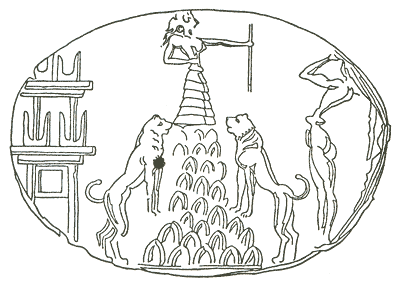
Aphrodite, then, had to be included among the Olympian gods.
But
their total number, twelve, apparently could not be exceeded. The
solution was ingenious: Add one by dropping one. Since Hades was
given domain over the Lower World and did not remain among the Great
Gods on Mount Olympus, a vacancy was created, admirably handy for
seating Aphrodite in the exclusive Circle of Twelve.
It also appears that the number twelve was a requirement that worked
both ways: There could be no more than twelve Olympians, but no
fewer than twelve, either. This becomes evident through the
circumstances that led to the inclusion of Dionysus in the Olympian
Circle. He was a son of Zeus, born when Zeus impregnated his own
daughter, Semele.
Dionysus, who had to be hidden from Hera's wrath,
was sent to far-off lands (reaching even India), introducing vinegrowing and winemaking wherever he went. In the meantime, a
vacancy became available on Olympus. Hestia, the oldest sister of
Zeus, weaker and older, was dropped entirely from the Circle of
Twelve. Dionysus then returned to Greece and was allowed to fill the
vacancy. Once again, there were twelve Olympians.
Though Greek mythology was not clear regarding the origins of
mankind, the legends and traditions claimed descent from the gods
for heroes and kings. These semi-gods formed the link between the
human destiny - daily toil, dependence on the elements, plagues,
illness, death - and a golden past, when only the gods roamed Earth.
And although so many of the gods were born on Earth, the select
Circle of Twelve Olympians represented the celestial aspect of the
gods.
The original Olympus was described by the Odyssey as lying in
the "pure upper air." The original Twelve Great Gods were Gods of
Heaven who had come down to Eearth; and they represented the twelve
celestial bodies in the "vault of Heaven."
The Latin names of the Great Gods, given them when the Romans
adopted the Greek pantheon, clarify their astral associations: Gaea
was Earth; Hermes, Mercury; Aphrodite, Venus; Ares, Mars; Cronus,
Saturn; and Zeus, Jupiter.
Continuing the Greek tradition, the
Romans envisaged Jupiter as a thundering god whose weapon was the
lightning bolt; like the Greeks, the Romans associated him with the
bull.
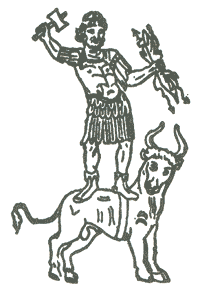
There is now general agreement that the foundations of the distinct
Greek civilization were laid on the island of Crete, where the
Minoan culture flourished from circa 2700 B.C. to 1400 B.C.
In
Minoan myth and legend, the tale of the minotaur is prominent. This
half-man, half-bull was the offspring of Pasiphae, the wife of King Minos, and a bull. Archaeological finds have confirmed the extensive
Minoan worship of the bull, and some cylinder seals depict the bull
as a divine being accompanied by a cross symbol, which stood for
some unidentified star or planet.
It has therefore been surmised
that the bull worshiped by the Minoans was not the common earthly
creature but the Celestial Bull - the constellation Taurus - in
commemoration of some events that had occurred when the Sun's spring
equinox appeared in that constellation, circa 4000 B.C.

By Greek tradition, Zeus arrived on the Greek mainland via Crete,
whence he had fled (by swimming the Mediterranean) after abducting
Europa, the beautiful daughter of the king of the Phoenician city of
Tyre. Indeed, when the earliest Minoan script was finally deciphered
by Cyrus H. Gordon, it was shown to be "a Semitic dialect from the
shores of the Eastern Mediterranean."
Gods came directly to Greece from the heavens. Zeus arrived from
across the Mediterranean, via Crete. Aphrodite was said to have come
by sea from the Near East, via Cyprus. Poseidon (Neptune to the
Romans) brought the horse with him from Asia Minor. Athena brought
"the olive, fertile and self-sown," to Greece from the lands of the
Bible.
There is no doubt that the Greek traditions and religion arrived on
the Greek mainland from the Near East, via Asia Minor and the
Mediterranean islands. It is there that their pantheon had its
roots; it is there that we should look for the origins of the Greek
gods, and their astral relationship with the number twelve.
Hinduism, the ancient religion of India, considers the Vedas -
compositions of hymns, sacrificial formulas, and other sayings
pertaining to the gods - as sacred scriptures, "not of human
origin:" The gods themselves composed them, the Hindu traditions
say, in the age that preceded the present one.
But, as time went on,
more and more of the original 100,000 verses, passed from generation
to generation orally, were lost and confused. In the end, a sage
wrote down the remaining verses, dividing them into four books and
trusting four of his principal disciples to preserve one Veda each.
When, in the nineteenth century, scholars began to decipher and
understand forgotten languages and trace the connections between
them, they realized that the Vedas were written in a very ancient
Indo-European language, the predecessor of the Indian root-tongue
Sanskrit, of Greek, Latin, and other European languages. When they
were finally able to read and analyze the Vedas, they were surprised
to see the uncanny similarity between the Vedic tales of the gods
and the Greek ones.
The gods, the Vedas told, were all members of one large, but not
necessarily peaceful, family. Amid the tales of ascents to the
heavens and descents to Earth, aerial battles, wondrous weapons,
friendships and rivalries, marriages and infidelities, there appears
to have existed a basic concern for genealogical record keeping -
who fathered whom, and who was the firstborn of whom.
The gods on
Earth originated in the heavens; and the principal deities, even on
Earth, continued to represent celestial bodies.
In primeval times, the Rishis ("primeval flowing ones") "flowed"
celestially, possessed of irresistible powers. Of them, seven were
the Great Progenitors. The gods Rahu ("demon") and Ketu
("disconnected") were once a single celestial body that sought to
join the gods without permission; but the God of Storms hurled his
flaming weapon at him, cutting him into two parts - Rahu, the
"Dragon's Head," which unceasingly traverses the heavens in search
of vengeance, and Ketu, the "Dragon's Tail."
Mar-Ishi, the
progenitor of the Solar Dynasty, gave birth to Kash-Yapa ("he who is
the throne"). The Vedas describe him as having been quite prolific;
but the dynastic succession was continued only through his ten
children by Prit-Hivi ("heavenly mother").
As dynastic head, Kash-Yapa was also chief of the devas ("shining
ones") and bore the title Dyaus-Pitar ("shining father"). Together
with his consort and ten children, the divine family made up the
twelve Adityas, gods who were each assigned a sign of the zodiac and
a celestial body. Kash-Yapa's celestial body was "the shining star";
Prit-Hivi represented Earth.
Then there were the gods whose
celestial counterparts included the Sun, the Moon, Mars, Mercury,
Jupiter, Venus, and Saturn.
In time, the leadership of the pantheon of twelve passed lo Varuna,
the God of the Heavenly Expanse. He was omnipresent and all-seeing;
one of the hymns to him reads almost like a biblical psalm:
It is he who makes the sun shine in the heavens,
And the winds that blow are his breath.
He has hollowed out the channels of the rivers;
They flow at his command.
He has made the depths of the sea.
His reign also came sooner or later to an end.
Indra, the god who
slew the celestial "Dragon," claimed the throne by slaying his
father. He was the new Lord of the Skies and God of Storms.
Lightning and thunder were his weapons, and his epithet was Lord of
Hosts. He had, however, to share dominion with his two brothers. One
was Vivashvat, who was the progenitor of Manu, the first Man.
The
other was Agni ("igniter"), who brought fire down to Earth from the
heavens, so that Mankind could use it industrially.
The similarities between the Vedic and Greek pantheons are obvious.
The tales concerning the principal deities, as well as the verses
dealing with a multitude of other lesser deities - sons, wives,
daughters, mistresses - are clearly duplicates (or originals?) of
the Greek tales.
There is no doubt that Dyaus came to mean Zeus;
Dyaus-Pitar, Jupiter; Varuna, Uranus; and so on. And, in both
instances, the Circle of the Great Gods always stood at twelve, no
matter what changes took place in the divine succession.
How could such similarity arise in two areas so far apart,
geographically and in time?
Scholars believe that sometime in the second millennium B.C. a
people speaking an Indo-European language, and centered in northern
Iran or the Caucasus area, embarked on great migrations. One group
went southeast, to India. The Hindus called them Aryans ("noble
men"). They brought with them the Vedas as oral tales, circa 1500
B.C.
Another wave of this Indo-European migration went westward, to
Europe. Some circled the Black Sea and arrived in Europe via the
steppes of Russia. But the main route by which these people and
their traditions and religion reached Greece was the shortest one:
Asia Minor. Some of the most ancient Greek cities, in fact, lie not
on the Greek mainland but at the western tip of Asia Minor.
But who were these Indo-Europeans who chose Anatolia as their abode?
Little in Western knowledge shed light on the subject.
Once again, the only readily available - and reliable - source
proved to be the Old Testament. There the scholars found several
references to the "Hittites" as the people inhabiting the mountains
of Anatolia. Unlike the enmity reflected in the Old Testament toward
the Canaanites and other neighbors whose customs were considered an
"abomination," the Hittites were regarded as friends and allies to
Israel.
Bathsheba, whom King David coveted, was the wife of Uriah
the Hittite, an officer in King David's army. King Solomon, who
forged alliances by marrying the daughters of foreign kings, took as
wives the daughters both of an Egyptian pharaoh and of a Hittite
king.
At another time, an invading Syrian army fled upon hearing a
rumor that,
"the king of Israel hath hired against us the kings of
the Hittites and the kings of the Egyptians."
These brief allusions
to the Hittites reveal the high esteem in which their military
abilities were held by other peoples of the ancient Near East.
With the decipherment of the Egyptian hieroglyphs - and, later on,
of the Mesopotamian inscriptions - scholars have come across
numerous references to a "Land of Hatti" as a large and powerful
kingdom in Anatolia. Could such an important power have left no
trace?
Forearmed with the clues provided in the Egyptian and Mesopotamian
texts, the scholars embarked on excavations of ancient sites in
Anatolia's hilly regions. The efforts paid off: They found Hittite
cities, palaces, royal treasures, royal tombs, temples, religious
objects, tools, weapons, art objects. Above all, they found many
inscriptions - both in a pictographic script and in cuneiform. The
biblical Hittites had come to life.
A unique monument bequeathed to us by the ancient Near East is a
rock carving outside the ancient Hittite capital (the site is
nowadays called Yazilikaya, which in Turkish means "inscribed
rock").
After passing through gateways and sanctuaries, the ancient
worshiper came into an open-air gallery, an opening among a
semicircle of rocks, on which all the gods of the Hittites were
depicted in procession.

Marching in from the left is a long procession of primarily male
deities, clearly organized in "companies" of twelve. At the extreme
left, and thus last to march in this amazing parade, are twelve
deities who look identical, all carrying the same weapon.
The middle group of twelve marchers includes some deities who look
older, some who bear diversified weapons, and two who are
highlighted by a divine symbol.

The third (front) group of twelve is clearly made up of the more
important male and female deities.
Their weapons and emblems are
more varied; four have the divine celestial symbol above them; two
are winged. This group also includes non-divine participants: two
bulls holding up a globe, and the king of the Hittites, wearing a
skull cap and standing under the emblem of the Winged Disk.
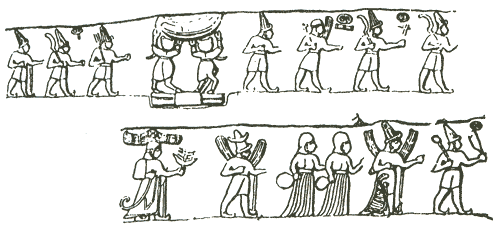
Marching in from the right were two groups of female deities; the
rock carvings are, however, too mutilated to ascertain their full
original number. We will probably not be wrong in assuming that
they, too, made up two "companies" of twelve each.
The two processions from the left and from the right met at a
central panel which clearly depicted Great Gods, for they were all
shown elevated, standing atop mountains, animals, birds, or even on
the shoulders of divine attendants.
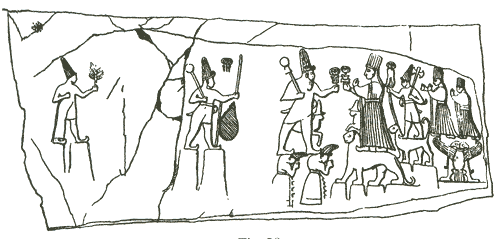
Much effort was invested by scholars (for example, E. Laroche, Le
Pantheon de Yazilikaya) to determine from the depictions, the
hieroglyphic symbols, as well as from partly legible texts and god
names that were actually carved on the rocks, the names, titles, and
roles of the deities included in the procession.
But it is clear
that the Hittite pantheon, too, was governed by the "Olympian"
twelve. The lesser gods were organized in groups of twelve, and the
Great Gods on Earth were associated with twelve celestial bodies.
That the pantheon was governed by the "sacred number" twelve is made
additionally certain by yet another Hittite monument, a masonry
shrine found near the present-day Beit-Zehir.
It clearly depicts the
divine couple, surrounded by ten other gods - making a total of
twelve.
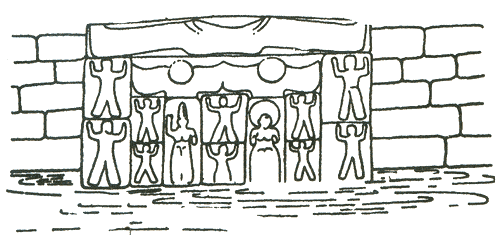
The archaeological finds showed conclusively that the Hittites
worshiped gods that were "of Heaven and Earth," all interrelated and
arranged into a genealogical hierarchy.
Some were great and "olden"
gods who were originally of the heavens. Their symbol - which in the
Hittite pictographic writing meant "divine" or "heavenly god" -
looked like a pair of eye goggles.
It frequently appeared on round
seals as part of a rocket-like object.
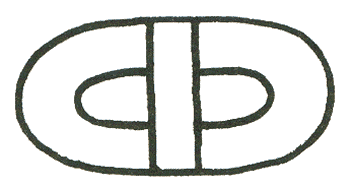

Other gods were actually present, not merely on Earth but among the
Hittites, acting as supreme rulers of the land, appointing the human
kings, and instructing the latter in matters of war, treaties, and
other international affairs.
Heading the physically present Hittite gods was a deity named Teshub,
which meant "wind blower." He was thus what scholars call a Storm
God, associated with winds, thunder, and lightning. He was also
nicknamed Taru ("bull").
Like the Greeks, the Hittites depicted bull
worship; like Jupiter after him, Teshub was depicted as the God of
Thunder and Lightning, mounted upon a bull.

Hittite texts, like later Greek legends, relate how then-chief deity
had to battle a monster to consolidate his supremacy.
A text named
by the scholars "The Myth of the Slaying of the Dragon" identifies Teshub's adversary as the god Yanka. Failing to defeat him in
battle, Teshub appealed to the other gods for help, but only one
goddess came to his assistance, and disposed of Yanka by getting him
drunk at a party.
Recognizing in such tales the origins of the legend of Saint George
and the Dragon, scholars refer to the adversary smitten by the
"good" god as "the dragon."
But the fact is that Yanka meant
"serpent," and that the ancient peoples depicted the "evil" god as
such - as seen in this bas-relief from a Hittite site.
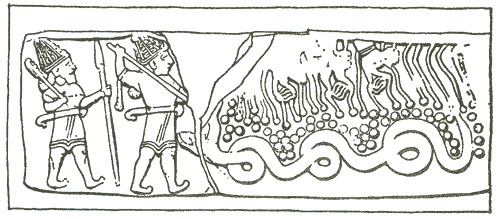
Zeus, too, as
we have shown, battled not a "dragon" but a serpent-god.
As we shall
show later on, there was deep meaning attached to these ancient
traditions of a struggle between a god of winds and a serpent deity.
Here, however, we can only stress that battles among the gods for
the divine Kingship were reported in the ancient texts as events
that had unquestionably taken place.
A long and well-preserved Hittite epic tale, entitled "Kingship in
Heaven," deals with this very subject - the heavenly origin of the
gods.
The recounter of those pre-mortal events first called upon
twelve "mighty olden gods" to listen to his tale, and be witnesses
to its accuracy:
Let there listen the gods who are in Heaven,
And those who are upon the dark-hued Earth!
Let there listen, the mighty olden gods.
Thus establishing that the gods of old were both of Heaven and upon
Earth, the epic lists the twelve "mighty olden ones," the forebears
of the gods; and assuring their attention, the recounter proceeded
to tell how the god who was "king in Heaven" came to "dark-hued
Earth":
Formerly, in the olden days, Alalu was king in Heaven;
He, Alalu, was seated on the throne.
Mighty Anu, the first among the gods, stood before him,
Bowed at his feet, set the drinking cup in his hand.
For nine counted periods, Alalu was king in Heaven.
In the ninth period, Anu gave battle against Alalu.
Alalu was defeated, he fled before Anu -
He descended to the dark-hued Earth.
Down to the dark-hued Earth he went;
On the throne sat Anu.
The epic thus attributed the arrival of a "king in Heaven" upon
Earth to a usurpation of the throne: A god named Alalu was
forcefully deposed from his throne (somewhere in the heavens), and,
fleeing for his life, "descended to dark-hued Earth." But that was
not the end.
The text proceeded to recount how Anu, in turn, was
also deposed by a god named Kumarbi (Anu's own brother, by some
interpretations).
There is no doubt that this epic, written a thousand years before
the Greek legends were composed, was the forerunner of the tale of
the deposing of Uranus by Cronus and of Cronus by Zeus. Even the
detail pertaining to the castration of Cronus by Zeus is found in
the Hittite text, for that was exactly what Kumarbi did to Anu:
For nine counted periods Anu was king in Heaven;
In the ninth period, Anu had to do battle with Kumarbi.
Anu slipped out of Kumarbi's hold and fled -
Flee did Anu, rising up to the sky.
After him Kumarbi rushed, seized him by his feet;
He pulled him down from the skies.
He bit his loins; and the "Manhood" of Anu
with the insides of Kumarbi combined, fused as bronze.
According to this ancient tale, the battle did not result in a total
victory.
Though emasculated, Anu managed to fly back to his Heavenly
Abode, leaving Kumarbi in control of Earth. Meanwhile, Anu's
"Manhood" produced several deities within Kumarbi's insides, which
he (like Cronus in the Greek legends) was forced to release. One of
these was Teshub, the chief Hittite deity.
However, there was to be one more epic battle before Teshub could
rule in peace.
Learning of the appearance of an heir to Anu in Kummiya ("heavenly
abode"), Kumarbi devised a plan to "raise a rival to the God of
Storms." "Into his hand he took his staff; upon his feet he put the
shoes that are swift as winds"; and he went from his city Ur-Kish to
the abode of the Lady of the Great Mountain.
Reaching her,
His desire was aroused; He slept with Lady Mountain; His manhood
flowed into her. Five times he took her... Ten times he took
her.
Was Kumarbi simply lustful? We have reason to believe that much more
was involved.
Our guess would be that the succession rules of the
gods were such that a son of Kumarbi by the Lady of the Great
Mountain could have claimed to be the rightful heir to the Heavenly
Throne; and that Kumarbi "took" the goddess five and ten times in
order to make sure that she conceived, as indeed she did: she bore a
son, whom Kumarbi symbolically named Ulli-Kummi ("suppressor of
Kummiya" - Teshub's abode).
The battle for succession was foreseen by Kumarbi as one that would
entail fighting in the heavens.
Having destined his son to suppress
the incumbents at Kummiya, Kumarbi further proclaimed for his son:
Let him ascend to Heaven for kingship!
Let him vanquish Kummiya, the beautiful city!
Let him attack the God of Storms
And tear him to pieces, like a mortal!
Let him shoot down all the gods from the sky.
Did the particular battles fought by Teshub upon Earth and in the
skies take place when the Age of Taurus commenced, circa 4000 B.C.?
Was it for that reason that the winner was granted association with
the bull? And were
the events in any way connected with the beginning, at the very same
time, of the sudden civilization of Sumer?
There can be no doubt that the Hittite pantheon and tales of the
gods indeed had their roots in Sumer, its civilization, and its
gods.
The tale of the challenge to the Divine Throne by Ulli-Kummi
continues to relate heroic battles but of an indecisive nature. At
one point, the failure of Teshub to defeat his adversary even caused
his spouse, Hebat, to attempt suicide. Finally, an appeal was made
to the gods to mediate the dispute, and an Assembly of the Gods was
called.
It was led by an "olden god" named Enlil, and another "olden
god" named Ea, who was called upon to produce "the old tablets with
the words of destiny" - some ancient records that could apparently
help settle the dispute regarding the divine succession.
When these records failed to settle the dispute, Enlil advised
another battle with the challenger, but with the help of some very
ancient weapons.
"Listen, ye olden gods, ye who know the olden
words," Enlil said to his followers:
Open ye the ancient storehouses
Of the fathers and the forefathers!
Bring forth the Olden Copper lance
With which Heaven was separated from Earth;
And let them sever the feet of Ulli-kummi.
Who were these "olden gods"? The answer is obvious, for all of them
- Anu, Antu, Enlil, Ninlil, Ea, Ishkur - bear Sumerian names. Even
the name of Teshub, as well as the names of other "Hittite" gods,
were often written in Sumerian script to denote their identities.
Also, some of the places named in the action were those of ancient
Sumerian sites.
It dawned on the scholars that the Hittites in fact worshipped a
pantheon of Sumerian origins, and that the arena of the tales of the
"olden gods" was Sumer.
This, however, was only part of a much wider
discovery. Not only was the Hittite language found to be based on
several Indo-European dialects, but it was also found to be subject
to substantial Akkadian influence, both in speech and more so in
writing. Since Akkadian was the international language of the
ancient world in the second millennium B.C., its influence on
Hittite could somehow be rationalized.
But there was cause for true astonishment when scholars discovered
in the course of deciphering Hittite that it extensively employed
Sumerian pictographic signs, syllables, and even whole words!
Moreover, it became obvious that Sumerian was their language of high
learning.
The Sumerian language, in the words of
O. R. Gurney (The
Hittites),
"was intensively studied at Hattu-Shash [the capital
city] and Sumerian-Hittite vocabularies were found there... Many
of the syllables associated with the cuneiform signs in the Hittite
period are really Sumerian words of which the meaning had been
forgotten [by the Hittites]... In the Hittite texts the scribes
often replaced common Hittite words by the corresponding Sumerian or
Babylonian word."
Now, when the Hittites reached Babylon sometime after 1600 B.C., the
Sumerians were already long gone from the Near Eastern scene. How
was it, then, that their language, literature, and religion
dominated another great kingdom in another millennium and in another
part of Asia?
The bridge, scholars have recently discovered, were a people called
the Hurrians.
Referred to in the Old Testament as the Horites ("free people"),
they dominated the wide area between Sumer and Akkad in Mesopotamia
and the Hittite kingdom in Anatolia. In the north their lands were
the ancient "cedar lands" from which countries near and far obtained
their best woods.
In the east their centers embraced the present-day
oil fields of Iraq; in one city alone, Nuzi, archaeologists found
not only the usual structures and artifacts but also thousands of
legal and social documents of great value. In the west, the Hurrians'
rule and influence extended to the Mediterranean coast and
encompassed such great ancient centers of trade, industry, and
learning as Carchemish and Alalakh.
But the seats of their power, the main centers of the ancient trade
routes, and the sites of the most venerated shrines were within the
heartland that was "between the two rivers," the biblical Naharayim.
Their most ancient capital (as yet undiscovered) was located
somewhere on the Khabur River.
Their greatest trading center, on the Balikh River, was the biblical Haran - the city where the family of
the patriarch Abraham sojourned on their way from Ur in southern
Mesopotamia to the Land of Canaan.
Egyptian and Mesopotamian royal documents referred to the Human
kingdom as Mitanni, and dealt with it on an equal footing - a strong
power whose influence spread beyond its immediate borders. The
Hittites called their Human neighbors "Hurri."
Some scholars pointed
out, however, that the word could also be read "Har," and (like G.
Contenau in La Civilisation des Hittites et des Hurrites du Mitanni)
have raised the possibility that, in the name "Harri,"
"one sees the
name 'Ary' or Aryans for these people."
There is no doubt that the Hurrians were Aryan or Indo-European in
origin.
Their inscriptions invoked several deities by their Vedic
"Aryan" names, their kings bore Indo-European names, and their
military and cavalry terminology derived from the Indo-European. B. Hrozny, who in the 1920s led an effort to unravel the Hittite and
Human records, even went so far as to call the Hurrians "the oldest
Hindus."
These Hurrians dominated the Hittites culturally and religiously.
The Hittite mythological texts were found to be of Hurrian
provenance, and even epic tales of prehistoric, semi-divine heroes
were of Hurrian origin. There is no longer any doubt that the
Hittites acquired their cosmology, their "myths," their gods, and
their pantheon of twelve from the Hurrians.
The triple connection - between Aryan origins, Hittite worship, and
the Hurrian sources of these beliefs - is remarkably well documented
in a Hittite prayer by a woman for the life of her sick husband.
Addressing her prayer to the goddess Hebat, Teshub's spouse, the
woman intoned:
Oh goddess of the Rising Disc of Arynna,
My Lady, Mistress of the Hatti Lands,
Queen of Heaven and Earth. . . .
In the Hatti country, thy name is
"Goddess of the Rising Disc of Arynna";
But in the land that thou madest,
In the Cedar Land,
Thou bearest the name "Hebat."
With all that, the culture and religion adopted and transmitted by
the Hurrians were not Indo-European. Even their language was not
really Indo-European.
There were undoubtedly Akkadian elements in
the Hurrian language, culture, and traditions. The name of their
capital, Washugeni, was a variant of the Semitic resh-eni ("where
the waters begin"). The Tigris River was called Aranzakh, which (we
believe) stemmed from the Akkadian words for "river of the pure
cedars." The gods Shamash and Tash-metum became the Hurrian Shimiki
and Tashimmetish - and so on.
But since the Akkadian culture and religion were only a development
of the original Sumerian traditions and beliefs, the Hurrians, in
fact, absorbed and transmitted the religion of Sumer. That this was
so was also evident from the frequent use of the original Sumerian
divine names, epithets, and writing signs.
The epic tales, it has become clear, were the tales of Sumer; the
"dwelling places" of the olden gods were Sumerian cities; the "olden
language" was the language of Sumer. Even the Hurrian art duplicated
Sumerian art - its form, its themes, and its symbols.
When and how were the Hurrians "mutated" by the Sumerian "gene"?
Evidence suggests that the Hurrians, who were the northern neighbors
of Sumer and Akkad in the second millennium B.C., had actually
commingled with the Sumerians in the previous millennium. It is an
established fact that Hurrians were present and active in Sumer in
the third millennium B.C., that they held important positions in
Sumer during its last period of glory, that of the third dynasty of
Ur.
There is evidence showing that the Hurrians managed and manned
the garment industry for which Sumer (and especially Ur) was known
in antiquity. The renowned merchants of Ur were probably Hurrians
for the most part.
In the thirteenth century B.C., under the pressure of vast
migrations and invasions (including the Israelite thrust from Egypt
to Canaan), the Hurrians retreated to the northeastern portion of
their kingdom. Establishing their new capital near Lake Van, they
called their kingdom Urartu ("Ararat"). There they worshiped a
pantheon headed by Tesheba (Teshub), depicting him as a vigorous god
wearing a horned cap and standing upon his cult symbol, the bull.
They called their main shrine Bitanu ("house of Anu") and dedicated
themselves to making their kingdom "the fortress of the valley of
Anu."

And Anu, as we shall see, was the Sumerian Father of the Gods.
What about the other avenue by which the tales and worship of the
gods reached Greece - from the eastern shores of the Mediterranean,
via Crete and Cyprus?
The lands that are today Israel, Lebanon, and southern Syria - which
formed the southwestern band of the ancient Fertile Crescent - were
then the habitat of peoples that can be grouped together as the
Canaanites. Once again, all that was known of them until rather
recently appeared in references (mostly adverse) in the Old
Testament and scattered Phoenician inscriptions.
Archaeologists were
only beginning to understand the Canaanites when two discoveries
came to light: certain Egyptian texts at Luxor and Saqqara, and,
much more important, historical, literary, and religious texts
unearthed at a major Canaanite center. The place, now called Ras
Shamra, on the Syrian coast, was the ancient city of Ugarit.
The language of the Ugarit inscriptions, the Canaanite language, was
what scholars call West Semitic, a branch of the group of languages
that also includes the earliest Akkadian and present-day Hebrew.
Indeed, anyone who knows Hebrew well can follow the Canaanite
inscriptions with relative ease. The language, literary style, and
terminology are reminiscent of the Old Testament.
The pantheon that unfolds from the Canaanite texts bears many
similarities to the later Greek one. At the head of the Canaanite
pantheon, too, there was a supreme deity called El, a word that was
both the personal name of the god and the generic term meaning
"lofty deity." He was the final authority in all affairs, human or
divine. Ab Adam ("father of man”) was his title; the Kindly, the
Merciful was his epithet.
He was the "creator of things created, and
the one who alone could bestow kingship."
The Canaanite texts ("myths" to most scholars) depicted El as a
sage, elderly deity who stayed away from daily affairs. His abode
was remote, at the "headwaters of the two rivers" - the Tigris and
Euphrates. There he would sit on his throne, receive emissaries, and
contemplate the problems and disputes the other gods brought before
him.
A stela found in Palestine depicts an elderly deity sitting on a
throne and being served a beverage by a younger deity. The seated
deity wears a conical headdress adorned with horns - a mark of the
gods, as we have seen, from prehistoric times - and the scene is
dominated by the symbol of a winged star - the ubiquitous emblem
that we shall increasingly encounter.
It is generally accepted by
the scholars that this sculptured relief depicts
El, the senior
Canaanite deity.

El, however, was not always an olden lord.
One of his epithets was
Tor (meaning "bull"), signifying, scholars believe, his sexual
prowess and his role as Father of the Gods. A Canaanite poem, called
"Birth of the Gracious Gods," placed El at the seashore (probably
naked), where two women were completely charmed by the size of his
penis. While a bird was roasting on the beach, El had intercourse
with the two women. Thus were the two gods
Shahar ("dawn") and Shalem ("completion" or "dusk") born.
These were not his only children nor his principal sons (of which he
had, apparently, seven). His principal son was Baal - again the
personal name of the deity, as well as the general term for "lord."
As the Greeks did in their tales, the Canaanites spoke of the
challenges by the son to the authority and rule of his father.
Like
El his father, Baal was what the scholars call a Storm God, a God of
Thunder and Lightning. A nickname for Baal was Hadad ("sharp one").
His weapons were the battle-ax and the lightning-spear; his cult
animal, like El's, was the bull, and, like El, he was depicted
wearing the conical headdress adorned with a pair of horns.
Baal was also called Elyon ("supreme"); that is, the acknowledged
prince, the heir apparent. But he had not come by this title without
a struggle, first with his brother Yam ("prince of the sea"), and
then with his brother Mot.
A long and touching poem, pieced together
from numerous fragmented tablets, begins with the summoning of the
"Master Craftsman" to El's abode "at the sources of the waters, in
the midst of the headwaters of the two rivers":
Through the fields of El he comes
He enters the pavilion of the Father of Years.
At El's feet he bows, falls down,
Prostrates himself, paying homage.
The Master Craftsman is ordered to erect a palace for Yam as the
mark of his rise to power.
Emboldened by this, Yam sends his
messengers to the assembly of the gods, to ask for the surrender to
him of Baal. Yam instructs his emissaries to be defiant, and the
assembled gods do yield. Even El accepts the new lineup among his
sons. "Ba'al is thy slave, O Yam," he declares.
The supremacy of Yam, however, was short-lived. Armed with two
"divine weapons," Baal struggled with Yam and defeated him - only to
be challenged by Mot (the name meant "smiter"). In this struggle,
Baal was soon vanquished; but his sister Anat refused to accept this
demise of Baal as final. "She seized Mot, the son of El, and with a
blade she cleaved him."
The obliteration of Mot led, according to the Canaanite tale, to the
miraculous resurrection of Baal. Scholars have attempted to
rationalize the report by suggesting that the whole tale was only
allegorical, representing no more than a tale of the annual struggle
in the Near East between the hot, rainless summers that dry out the
vegetation, and the coming of the rainy season in the autumn, which
revives or "resurrects" the vegetation.
But there is no doubt that
the Canaanite tale intended no allegory, that it related what were
then believed to be the true events: how the sons of the chief deity
fought among themselves, and how one of them defied defeat to
reappear and become the accepted heir, making El rejoice:
El, the kindly one, the merciful, rejoices.
His feet on the footstool he sets.
He opens his throat and laughs;
He raises his voice and cries out:
"I shall sit and take my ease,
The soul shall repose in my breast;
For Ba'al the mighty is alive,
For the Prince of Earth exists!"
Anat, according to Canaanite traditions, thus stood by her brother
the Lord (Baal) in his life-and-death struggle with the evil Mot;
and the parallel between this and the Greek tradition of the goddess
Athena standing with the supreme god Zeus in his life-and-death
struggle with Typhon is only too obvious.
Athena, as we have seen,
was called "the perfect maiden," yet had many illicit love affairs.
Likewise, Canaanite traditions (which preceded the Greek ones)
employed the epithet "the Maiden Anat," and, in spite of this,
proceeded to report her various love affairs, especially with her
own brother Baal. One text describes the arrival of Anat at Baal's
abode on Mount Zaphon, and Baal's hurried dismissal of his wives.
Then he sank by his sister's feet; they looked into each other's
eyes; they anointed each other's "horns" -
He seizes and holds her womb. . . .
She seizes and holds his "stones.". . .
The maiden Anat... is made to conceive and bear.
No wonder, then, that Anat was often depicted completely naked, to
emphasize her sexual attributes - as in this seal impression, which
illustrates a helmeted Baal battling another god.
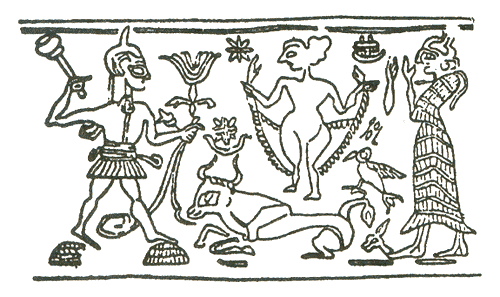
Like the Greek religion and its direct forerunners, the Canaanite
pantheon included a Mother Goddess, official consort of the chief
deity.
They called her Ashera; she paralleled the Greek Hera.
Astarte (the biblical Ashtoreth) paralleled Aphrodite; her frequent
consort was Athtar, who was associated with a bright planet, and who
probably paralleled Ares, Aphrodite's brother. There were other
young deities, male and female, whose astral or Greek parallels can
easily be surmised.
But besides these young deities there were the "olden gods," aloof
from mundane affairs but available when the gods themselves ran into
serious trouble. Some of their sculptures, even in a partly damaged
state, show them with commanding features, gods recognizable by
their horned headgear.
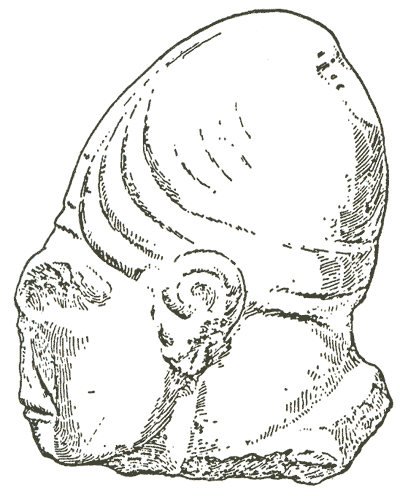
Whence had the Canaanites, for their part, drawn their culture and
religion?
The Old Testament considered them a part of the Hamitic family of
nations, with roots in the hot (for that is what ham meant) lands of
Africa, brothers of the Egyptians. The artifacts and written records
unearthed by archaeologists confirm the close affinity between the
two, as well as the many similarities between the Canaanite and
Egyptian deities.
The many national and local gods, the multitude of their names and
epithets, the diversity of their roles, emblems, and animal mascots
at first cast the gods of Egypt as an unfathomable crowd of actors
upon a strange stage.
But a closer look reveals that they were
essentially no different from those of the other lands of the
ancient world.

The Egyptians believed in Gods of Heaven arid Earth, Great Gods that
were clearly distinguished from the multitudes of lesser deities.
G.
A. Wainwright (The Sky-Religion in Egypt) summed up the evidence,
showing that the Egyptian belief in Gods of Heaven who descended to
Earth from the skies was "extremely ancient." Some of the epithets
of these Great Gods - Greatest God, Bull of Heaven, Lord/Lady of the
Mountains - sound familiar.
Although the Egyptians counted by the decimal system, their
religious affairs were governed by the Sumerian sexagesimal sixty,
and celestial matters were subject to the divine number twelve. The
heavens were divided into three parts, each comprising twelve
celestial bodies. The afterworld was divided into twelve parts. Day
and night were each divided into twelve hours.
And all these
divisions were paralleled by "companies" of gods, which in turn
consisted of twelve gods each.
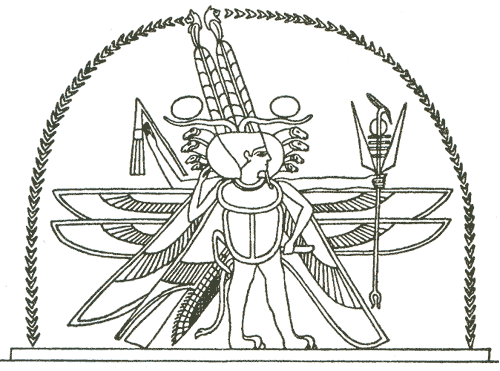
The head of the Egyptian pantheon was Ra ("creator"), who presided
over an Assembly of the Gods that numbered twelve.
He performed his
wondrous works of creation in primeval times, bringing forth Geb
("Earth") and Nut ("sky"). Then he caused the plants to grow on
Earth, and the creeping creatures - and, finally, Man. Ra was an
unseen celestial god who manifested himself only periodically. His
manifestation was the Aten - the Celestial Disc, depicted as a
Winged Globe.
The appearance and activities of Ra on Earth were, according to
Egyptian tradition, directly connected with kingship in Egypt.
According to that tradition, the first rulers of Egypt were not men
but gods, and the first god to rule over Egypt was Ra. He then
divided the kingdom, giving Lower Egypt to his son Osiris and Upper
Egypt to his son Seth.
But Seth schemed to overthrow Osiris and
eventually had Osiris drowned. Isis, the sister and wife of Osiris,
retrieved the mutilated body of Osiris and resur-rected him.
Thereafter, he went through "the secret gates" and joined Ra in his
celestial path; his place on the throne of Egypt was taken over by
his son Horus, who was sometimes depicted as a winged and horned
deity.
Though Ra was the loftiest in the heavens, upon Earth he was the son
of the god Ptah ("developer," "one who fashioned things"). The
Egyptians believed that Ptah actually raised the land of Egypt from
under floodwaters by building dike works at the point where the Nile
rises.
This Great God, they said, had come to Egypt from elsewhere;
he established not only Egypt but also "the mountain land and the
far foreign land." Indeed, the Egyptians acknowledged, all their
"olden gods" had come by boat from the south; and many prehistoric
rock drawings have been found that show these olden gods -
distinguished by their horned headdress - arriving in Egypt by boat.

The only sea route leading to Egypt from the south is the Red Sea,
and it is significant that the Egyptian name for it was the Sea of
Ur.
Hieroglyphically, the sign for Ur meant "the far-foreign [land]
in the east"; that it actually may also have referred to -he
Sumerian Ur, lying in that very direction, cannot be ruled out.
The Egyptian word for "divine being" or "god" was NTR, which meant
"one who watches." Significantly, that is exactly the meaning of the
name Shumer: the land of the "ones who watch."
The earlier notion that civilization may have begun in Egypt has
been discarded by now. There is ample evidence now showing that the
Egyptian-organized society and civilization, which began half a
millennium and more after the Sumerian one, drew its culture,
architecture, technology, art of writing, and many other aspects of
a high civilization from Sumer. The weight of evidence also shows
that the gods of Egypt originated in Sumer.
Cultural and blood kinsmen of the Egyptians, the Canaanites shared
the same gods with them. But, situated in the land strip that was
the bridge between Asia and Africa from time immemorial, the
Canaanites also came under strong Semitic or Mesopotamian
influences. Like the Hittites to the north, the Humans to the
northeast, the Egyptians to the south, the Canaanites could not
boast of an original pantheon. They, too, acquired their cosmogony,
deities, and legendary tales from elsewhere.
Their direct contacts
with the Sumerian sources were the Amorites.
The land of the Amorites lay between Mesopotamia and the
Mediterranean lands of western Asia. Their name derives from the
Akkadian amurru and Sumerian martu ("westerners"). They were not
treated as aliens but as related people who dwelt in the western
provinces of Sumer and Akkad.
Persons bearing Amorite names were listed as temple functionaries in
Sumer. When Ur fell to Elamite invaders circa 2000 B.C., a Martu
named Ishbi-Irra reestablished Sumerian kingship at Larsa and made
his first task the
recapture of Ur and the restoration there of the great shrine to the
god Sin. Amorite "chieftains" established the first independent
dynasty in Assyria circa 1900 B.C.
And Hammurabi, who brought
greatness to Babylon circa 1800 B.C., was the sixth successor of the
first dynasty of Babylon, which was Amorite.
In the 1930s archaeologists came upon the center and capital city of
the Amorites, known as Mari. At a bend of the Euphrates, where the
Syrian border now cuts the river, the diggers uncovered a major city
whose buildings were erected and continuously reerected, between
3000 and 2000 B.C., on foundations that date to centuries earlier.
These earliest remains included a step pyramid and temples to the
Sumerian deities Inanna, Ninhursag, and Enlil.
The palace of Mari alone occupied some five acres and included a
throne room painted with most striking murals, three hundred various
rooms, scribal chambers, and (most important to the historian) well
over twenty thousand tablets in the cuneiform script, dealing with
the economy, trade, politics, and social life of those times, with
state and military matters, and, of course, with the religion of the
land and its people.
One of the wall paintings at the great palace
of Mari depicts the investiture of the king Zimri-Lim by the goddess
Inanna (whom the Amorites called Ishtar).
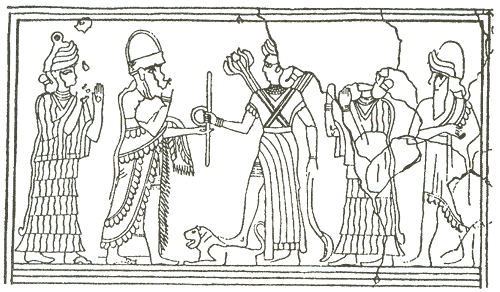
As in the other pantheons, the chief deity physically present among
the Amurru was a weather or storm god.
They called him Adad - the
equivalent of the Canaanite Baal ("lord") - and they nicknamed him
Hadad. His symbol, as might be expected, was fork lightning.
In Canaanite texts, Baal is often called the "Son of Dagon." The
Mari texts also speak of an older deity named Dagan, a "Lord of
Abundance" who - like El - is depicted as a retired deity, who
complained on one occasion that he was no longer consulted on the
conduct of a certain war.
Other members of the pantheon included the Moon God, whom the
Canaanites called Yerah, the Akkadians Sin, and the Sumerians Nannar;
the Sun God, commonly called Shamash; and other deities whose
identities leave no doubt that Mari was a bridge (geographically and
chronologically) connecting the lands and the peoples of the eastern
Mediterranean with the Mesopotamian .sources.
Among the finds at Mari, as elsewhere in the lands of Sumer, there
were dozens of statues of the people themselves: kings, nobles,
priests, singers.
They were invariably depicted with their hands
clasped in prayer, their gaze frozen forever toward their gods.
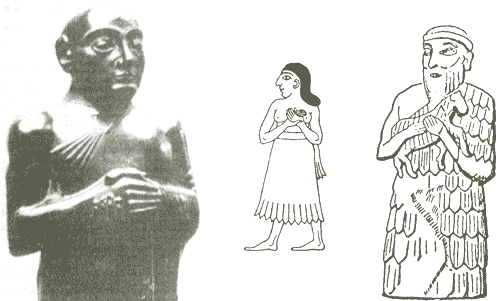
Who were these Gods of Heaven and Earth, divine yet human, always
headed by a pantheon or inner circle of twelve deities?
We have entered the temples of the Greeks and the Aryans, the
Hittites and the Hurrians, the Canaanites, the Egyptians, and the
Amorites. We have followed paths that took us across continents and
seas, and clues that carried us over several millennia.
And all the corridors of all the temples have led us to one source:
Sumer.
Return to Contents
|





















